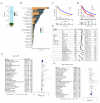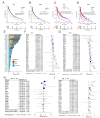Pan-cancer analysis of CDKN2A alterations identifies a subset of gastric cancer with a cold tumor immune microenvironment
- PMID: 38822443
- PMCID: PMC11143690
- DOI: 10.1186/s40246-024-00615-7
Pan-cancer analysis of CDKN2A alterations identifies a subset of gastric cancer with a cold tumor immune microenvironment
Abstract
Background: Although CDKN2A alteration has been explored as a favorable factor for tumorigenesis in pan-cancers, the association between CDKN2A point mutation (MUT) and intragenic deletion (DEL) and response to immune checkpoint inhibitors (ICIs) is still disputed. This study aims to determine the associations of CDKN2A MUT and DEL with overall survival (OS) and response to immune checkpoint inhibitors treatment (ICIs) among pan-cancers and the clinical features of CDKN2A-altered gastric cancer.
Methods: This study included 45,000 tumor patients that underwent tumor sequencing across 33 cancer types from four cohorts, the MSK-MetTropism, MSK-IMPACT, OrigiMed2020 and TCGA cohorts. Clinical outcomes and genomic factors associated with response to ICIs, including tumor mutational burden, copy number alteration, neoantigen load, microsatellite instability, tumor immune microenvironment and immune-related gene signatures, were collected in pan-cancer. Clinicopathologic features and outcomes were assessed in gastric cancer. Patients were grouped based on the presence of CDKN2A wild type (WT), CDKN2A MUT, CDKN2A DEL and CDKN2A other alteration (ALT).
Results: Our research showed that CDKN2A-MUT patients had shorter survival times than CDKN2A-WT patients in the MSK MetTropism and TCGA cohorts, but longer OS in the MSK-IMPACT cohort with ICIs treatment, particularly in patients having metastatic disease. Similar results were observed among pan-cancer patients with CDKN2A DEL and other ALT. Notably, CDKN2A ALT frequency was positively related to tumor-specific objective response rates to ICIs in MSK MetTropism and OrigiMed 2020. Additionally, individuals with esophageal carcinoma or stomach adenocarcinoma who had CDKN2A MUT had poorer OS than patients from the MSK-IMPACT group, but not those with adenocarcinoma. We also found reduced levels of activated NK cells, T cells CD8 and M2 macrophages in tumor tissue from CDKN2A-MUT or DEL pan-cancer patients compared to CDKN2A-WT patients in TCGA cohort. Gastric cancer scRNA-seq data also showed that CDKN2A-ALT cancer contained less CD8 T cells but more exhausted T cells than CDKN2A-WT cancer. A crucial finding of the pathway analysis was the inhibition of three immune-related pathways in the CDKN2A ALT gastric cancer patients, including the interferon alpha response, inflammatory response, and interferon gamma response.
Conclusions: This study illustrates the CDKN2A MUT and DEL were associated with a poor outcome across cancers. CDKN2A ALT, on the other hand, have the potential to be used as a biomarker for choosing patients for ICI treatment, notably in esophageal carcinoma and stomach adenocarcinoma.
Keywords: CDKN2A; Immune checkpoint inhibitor; Immunotherapy; Pan-cancer.
© 2024. The Author(s).
Conflict of interest statement
The authors declare that they have no known competing financial interests or personal relationships that could have appeared to influence the work reported in this paper.
Figures







References
-
- Lu VM, O’Connor KP, Shah AH, Eichberg DG, Luther EM, Komotar RJ, Ivan ME. The prognostic significance of CDKN2A homozygous deletion in IDH-mutant lower-grade glioma and glioblastoma: a systematic review of the contemporary literature. J Neurooncol. 2020;148(2):221–9. doi: 10.1007/s11060-020-03528-2. - DOI - PubMed
Publication types
MeSH terms
Substances
LinkOut - more resources
Full Text Sources
Medical
Research Materials
Miscellaneous

